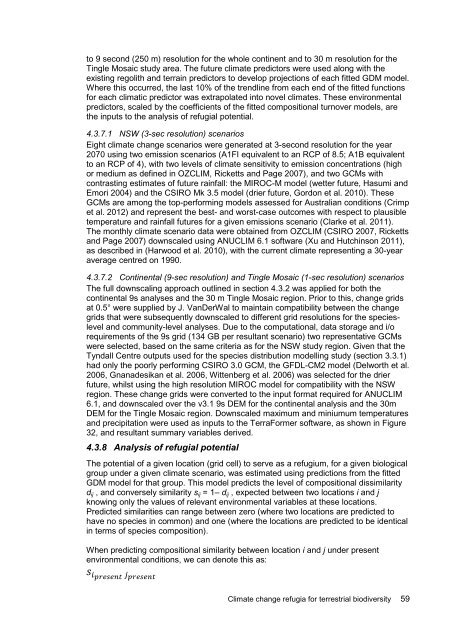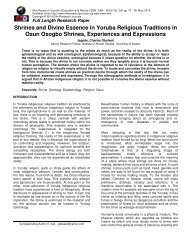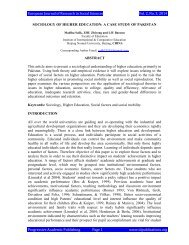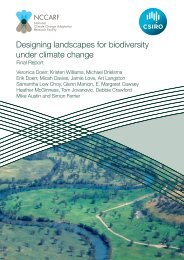Williams-Climate-change-refugia-for-terrestrial-biodiversity_0
Williams-Climate-change-refugia-for-terrestrial-biodiversity_0
Williams-Climate-change-refugia-for-terrestrial-biodiversity_0
Create successful ePaper yourself
Turn your PDF publications into a flip-book with our unique Google optimized e-Paper software.
to 9 second (250 m) resolution <strong>for</strong> the whole continent and to 30 m resolution <strong>for</strong> the<br />
Tingle Mosaic study area. The future climate predictors were used along with the<br />
existing regolith and terrain predictors to develop projections of each fitted GDM model.<br />
Where this occurred, the last 10% of the trendline from each end of the fitted functions<br />
<strong>for</strong> each climatic predictor was extrapolated into novel climates. These environmental<br />
predictors, scaled by the coefficients of the fitted compositional turnover models, are<br />
the inputs to the analysis of <strong>refugia</strong>l potential.<br />
4.3.7.1 NSW (3-sec resolution) scenarios<br />
Eight climate <strong>change</strong> scenarios were generated at 3-second resolution <strong>for</strong> the year<br />
2070 using two emission scenarios (A1FI equivalent to an RCP of 8.5; A1B equivalent<br />
to an RCP of 4), with two levels of climate sensitivity to emission concentrations (high<br />
or medium as defined in OZCLIM, Ricketts and Page 2007), and two GCMs with<br />
contrasting estimates of future rainfall: the MIROC-M model (wetter future, Hasumi and<br />
Emori 2004) and the CSIRO Mk 3.5 model (drier future, Gordon et al. 2010). These<br />
GCMs are among the top-per<strong>for</strong>ming models assessed <strong>for</strong> Australian conditions (Crimp<br />
et al. 2012) and represent the best- and worst-case outcomes with respect to plausible<br />
temperature and rainfall futures <strong>for</strong> a given emissions scenario (Clarke et al. 2011).<br />
The monthly climate scenario data were obtained from OZCLIM (CSIRO 2007, Ricketts<br />
and Page 2007) downscaled using ANUCLIM 6.1 software (Xu and Hutchinson 2011),<br />
as described in (Harwood et al. 2010), with the current climate representing a 30-year<br />
average centred on 1990.<br />
4.3.7.2 Continental (9-sec resolution) and Tingle Mosaic (1-sec resolution) scenarios<br />
The full downscaling approach outlined in section 4.3.2 was applied <strong>for</strong> both the<br />
continental 9s analyses and the 30 m Tingle Mosaic region. Prior to this, <strong>change</strong> grids<br />
at 0.5° were supplied by J. VanDerWal to maintain compatibility between the <strong>change</strong><br />
grids that were subsequently downscaled to different grid resolutions <strong>for</strong> the specieslevel<br />
and community-level analyses. Due to the computational, data storage and i/o<br />
requirements of the 9s grid (134 GB per resultant scenario) two representative GCMs<br />
were selected, based on the same criteria as <strong>for</strong> the NSW study region. Given that the<br />
Tyndall Centre outputs used <strong>for</strong> the species distribution modelling study (section 3.3.1)<br />
had only the poorly per<strong>for</strong>ming CSIRO 3.0 GCM, the GFDL-CM2 model (Delworth et al.<br />
2006, Gnanadesikan et al. 2006, Wittenberg et al. 2006) was selected <strong>for</strong> the drier<br />
future, whilst using the high resolution MIROC model <strong>for</strong> compatibility with the NSW<br />
region. These <strong>change</strong> grids were converted to the input <strong>for</strong>mat required <strong>for</strong> ANUCLIM<br />
6.1, and downscaled over the v3.1 9s DEM <strong>for</strong> the continental analysis and the 30m<br />
DEM <strong>for</strong> the Tingle Mosaic region. Downscaled maximum and miniumum temperatures<br />
and precipitation were used as inputs to the TerraFormer software, as shown in Figure<br />
32, and resultant summary variables derived.<br />
4.3.8 Analysis of <strong>refugia</strong>l potential<br />
The potential of a given location (grid cell) to serve as a refugium, <strong>for</strong> a given biological<br />
group under a given climate scenario, was estimated using predictions from the fitted<br />
GDM model <strong>for</strong> that group. This model predicts the level of compositional dissimilarity<br />
dij , and conversely similarity sij = 1– dij , expected between two locations i and j<br />
knowing only the values of relevant environmental variables at these locations.<br />
Predicted similarities can range between zero (where two locations are predicted to<br />
have no species in common) and one (where the locations are predicted to be identical<br />
in terms of species composition).<br />
When predicting compositional similarity between location i and j under present<br />
environmental conditions, we can denote this as:






